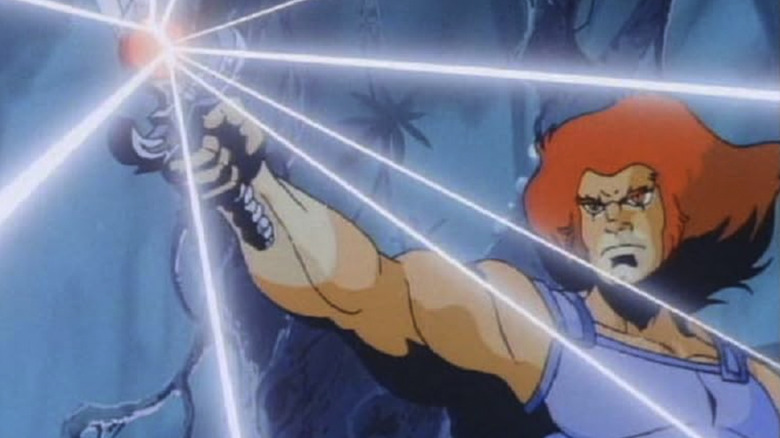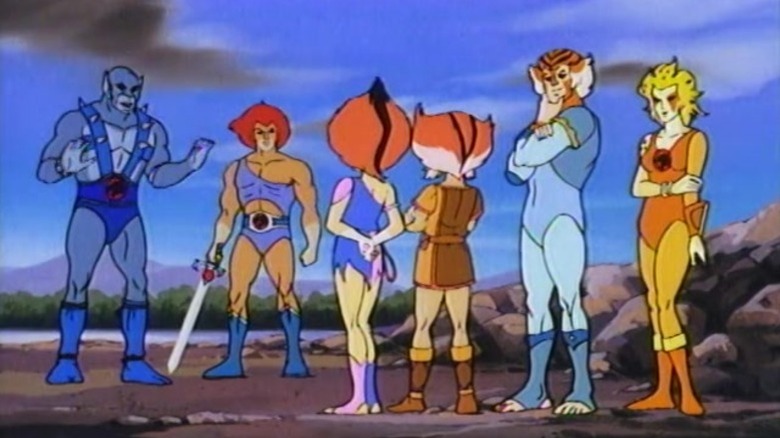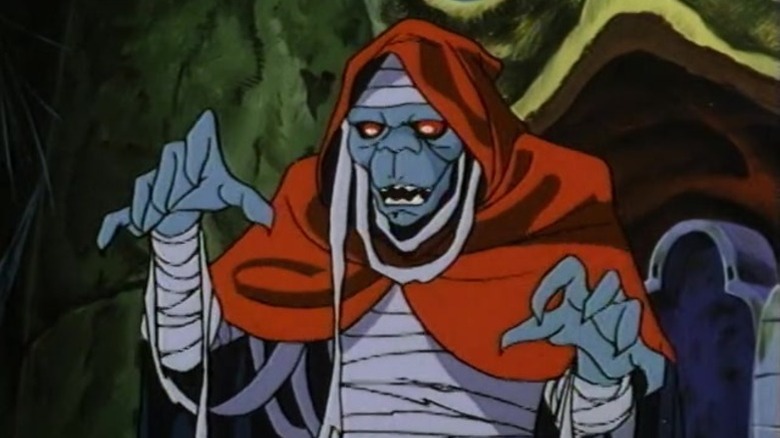Why ThunderCats Was Canceled
Tobin Wolf's 1985 animated TV series "ThunderCats" was a very, very odd beast. The titular characters were superpowered humanoid/feline aliens from the planet Thundara, living at an unspecified time in history. The plot follows the ThunderCats after the destruction of Thundara, and their subsequent relocation to a distant world called Third Earth. Third Earth is sparsely populated by benevolent robot teddy bears called Berbils, but is also home to the occasional beasts and monsters. In a faraway cave rests Mumm-Ra (Earl Hammond), an impossibly ancient mummy that aims to take over the world with magic spells. He is able to transform into a muscled wrestler for short spans.
The six ThunderCats have built a massive mechanical castle on Third Earth, and are led by the royal prince Lion-O (Larry Kenney), who is armed with the mystical Sword of Omens and a magical claw glove. His subjects include the fast-running Cheetara (Lynne Lipton), the engineer Panthro (Earle Hyman), the spiritual Tygra (Peter Newman), and the tweener twins WilyKit and WilyKat (Lipton and Newman). They also possessed a whining opossum-like gremlin named Snarf (Bob McFadden).
The series follows the ThunderCats' altercations with Mumm-Ra and his minions. "ThunderCats" was one of many toyetic shows of the 1980s, making huge amounts of cash from merch sales. Despite the bonkers fantasy premise and unusually deserted setting, "ThunderCats" was a hit, running for 130 episodes (!) over its four seasons. It ended its run in 1989.
Kids of the 1980s likely recall the controversy surrounding "ThunderCats." Like many of the shows of the era, "ThunderCats" was soul-suckingly toy-focused, tying its characters and vehicles into already-manufactured toy products that kids could buy. Consumer watchdog groups cited "ThunderCats" (and many others) as eroding the imaginations of children, priming them to be consumers of toys, not enriched human beings. Even Ronald Reagan got involved. The controversy helped push "ThunderCats" toward cancelation.
ThunderCats courted controversy, and then the studio lost interest
From the early 1960s up until the early 1980s, it was illegal to directly market to kids. Ronald Reagan, however, began haphazardly loosening regulations all over the private sector during his administration, and began to look the other way when toy companies like Hasbro began making toy-based shows that served as marketing directly to kids. Specifically, his head of the FCC, Mark Fowler, was actually doing the dirty work. Advertisers loved the deregulation, but the kids suffered, being offered shallow, action-based shows that essentially only functioned as toy commercials. Fowler also deliberately cut grants for educational programs or any shows with educational content. "Captain Kangaroo" and "Schoolhouse Rock" were defunded. A 2020 article in Medium describes the wild world of 1980s entertainment deregulation.
In 1990, when Bill Clinton was in office, many regulations were re-established. A 1990 article in The New York Times details the push-and-pull between the hog-happy advertisers and parents watchdog groups concerned about the money-based shows their kids had access to. Efforts to put new regulations into place were being spearheaded while "ThunderCats" was still on the air. In 1990, the FCC actually allowed shows like "ThunderCats" to remain on the air, with the slight stipulations that the violence be kept to a minimum, and that any unambiguous advertisements be left for ad breaks. It was legal to run "ThunderCats," but it rose and fell during a time of hot debate over the nature of kids' programming. After a while, it seemed like the fight wasn't worth it.
ThunderCats was too expensive to make after a while
It should also be noted that "ThunderCats" was expensive to make, mostly because it was so prolific. The first season was a daily show that ran 65 episodes (common at the time) over the course of only two months. Its continuous presence on television kept it popular, but that pace of production proved hard to maintain. For its second season, the networks decided that it was more cost-effective to reduce the number of episodes to only 25, and encapsulate the stories into a string of five-part miniseries. This pattern was maintained for the third and fourth seasons as well, but with only 20 episodes each.
The first five episodes of season 2 were released on VHS in 1987 as a straight-to-video movie called "ThunderCats — Ho!," which was initially planned as a theatrical feature. The film was turned back into television episodes, however, after films like "Transformers: The Movie" and "My Little Pony: The Movie" tanked at the box office. It seems that the kiddos only wanted their toy commercials at home; why pay extra to see them writ large?
After four years and some changing tides in the marketplace, though, "ThunderCats" became less popular, both with the studio and with audiences. It was canceled when ratings fell, unable to justify the cost of making it. By the '90s, animation had begun to mutate, however, with self-aware shows like "Tiny Toon Adventures" and creator-based comedies like "The Ren & Stimpy Show." The age of the original "ThunderCats" had came to an end.
Years later, we can see that the branding worked. A generation of kids, now adult, still remembers "ThunderCats" with fondness. The series was rebooted in 2011 and then again in 2020. A new movie may still be in the works. For some of us, we never learned to put down our toys.


